|
Duchy of Modena Ducato di Modena e Reggio The Duchy of Modena (in full, the Duchies of Modena and Reggio)
was a small Italian state that existed from 1452 to 1859, with a break between 1796 and 1814. The Duchy was originally
created for the Este family, who also ruled Ferrara until 1597. In 1796, the Duchy was occupied by the French army of Napoleon
Bonaparte, who created the Cispadane Republic out of its territory. The last Este Duke became ruler of former Austrian
territories in southwestern Germany (the Breisgau), and died in 1803. Following his death, Modena was inherited by his
son-in-law, Archduke Ferdinand of Austria-Este, an uncle of Emperor Francis II. With the fall of the Napoleonic system in
Italy in 1814, Ferdinand's son, Francis IV, became Duke of Modena. Soon after, he inherited the territories of Massa and Carrara
from his mother.  The Habsburg dukes were briefly ousted in 1831 and 1848, but
soon returned. Following the Franco-Piedmontese war against Austria in 1859, the duke was again forced to flee, this time
permanently. In December 1859, Modena joinedwith Tuscany and Parma to form the United Provinces of Central Italy, which were
annexed to the Kingdom of Sardinia in March 1860. Dukes of Modena and Pretenders - 1452 -Present In 1452 the Italian family of Este, Lords of Ferrara, were created Dukes of Modena and Reggio,
becoming Dukes of Ferrara also in 1471. In 1597, they lost the succession of Ferrara itself to the Papal States. They continued
to rule the Duchy of Modena and Reggio in the Emilia until 1796, when it became part of Napoleon Bonaparte's Cispadane Republic.
In 1814 it was restored under the Habsburg grandson of the last Este Duke, continuing until it was annexed by Piedmont-Sardinia
in 1859. Este
Dukes of Ferrara, Modena and Reggio - Borso 1450-1471 (Duke of Modena and Reggio from 1452, Duke of Ferrara from 1471)
- Ercole I 1471-1505
- Alfonso I 1505-1534
- Ercole
II 1534-1559
- Alfonso II 1559-1597
Este
Dukes of Modena and Reggio - Cesare 1597-1628 (lost Ferrara in January 1598 and moved the capital to Modena)
- Alfonso III 1628-1629 (died 1644)
- Francesco I 1629-1658
- Alfonso
IV 1658-1662
- Francesco II 1662-1694
- Rainaldo III 1694-1737
- Francesco III 1737-1780
- Ercole
III 1780-1796 (d. 1803)
Habsburg - Este Dukes of Modena and Reggio, 1814-1860
(from 1815 also Duke of Mirandola and from 1829
Duke of Massa and Prince of Carrara) - Francesco IV 1814-1846
- Francesco
V 1846-1859 (d. 1875)
Habsburg - Este Dukes of Modena and Reggio, post monarchy - Francis V (1859-1875)
- Francis Ferdinand, Archduke of Austria-Este (1875-1914)
- Charles, Archduke of Austria-Este (1914-1917)
- Robert, Archduke of Austria-Este (1917-1996)
- Lorenz, Archduke of Austria-Este (1996-Present)
- Heir : Amedeo of Belgium, Archduke of Austria-Este
Ducal House of Austria-Este Archduke of Austria-Este
(Italian: arciduca d'Austria-Este; German: Erzherzog von Österreich-Este) and Habsburg-Este (Italian: Asburgo-Este) are
a title and a surname which have been used by several cadet branches of the House of Habsburg-Lorraine to denote a connection
with the extinct Italian princely and feudal family of Este and the Duchy of Modena ruled by them. As a younger branch of
the House of Habsburg Lorraine, the Habsburg-Estes are also Archdukes and Archduchesses of Austria, Princes and Princesses
of Hungary and Bohemia. Ercole III d'Este, the last Este duke of Modena, of the direct line of Este, was deposed of rulership
in 1796 by the French as his Italian principality was incorporated into the Cisalpine Republic, later Napoleonic Kingdom of
Italy. However in 1814, when the French rule was abolished in Italy (but after the death of Duke Ercole), Modena was returned
to his daughter Mary Beatrice d'Este and her son Archduke Francis of Austria-Este. 
Duke Ercole
III was compensated with the principality of Breisgau, located in Southern Germany. Its former rulers, Habsburgs ceded this
province to him, in anticipation of it falling eventually to the Habsburg family again, since Ercole's sole daughter was married
to a cadet Habsburg, Archduke Ferdinand of Austria-Este. Duke Ercole died in 1803 and Breisgau was inherited by his daughter
(and her husband), who soon (1805) lost it to the expanding Grand Duchy of Baden. The family, cognatically descended from the Estes, ruled the Duchy of Modena and Reggio again from 1814
to 1859, using the names Asburgo-Este (Habsburg-Este) and its variants. The Duchy bore also titles Duke of Reggio, of Mirandola,
of Massa, Prince of Carrara and Lunigniana, as well as since 1847 Duke of Guastalla. The principality lost its independence
to the new united Italy, and Francesco V, the last duke was deposed. 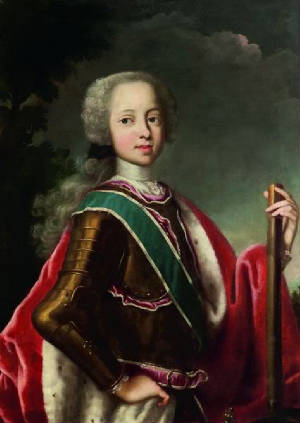
Duke
Francis V of Modena (1846-59, died 1875) withdrew to Austria where he live most of the rest of his life. After the death of
his mother in 1840, Francis was considered the legitimate heir to the English and Scottish thrones by Jacobites (with the
regnal title King Francis I). When Francis died at Vienna on November 20, 1875, his family became extinct in the male line.
His heir general and heir-of-the-blood was his niece, Archduchess Maria Theresia of Austria-Este (died 1919), who then was
married with Prince Ludwig of Bavaria (they later became King and Queen of Bavaria). The heir-general of line of the Este
family continues in their descendants, and the present heir is Franz, Duke of Bavaria. 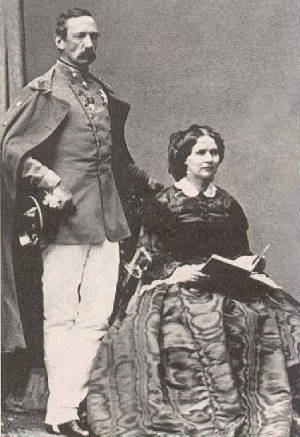
However,
Francis V, Duke of Modena had decided to retain the Este name in the Habsburg family, and left most of his huge estate to
his young cousin Archduke Franz Ferdinand of Austria, with certain conditions, one of which is that the heir and future heirs
use the name of Este. The tradition of Este family thus fell to the line of Archduke Charles Louis, younger brother to then
Emperor Francis Joseph. It is said that Austria-Este is some sort of "secundogeniture" title in Austrian imperial
family, however since it has continued to direct heirs of the originator of the branch, not reverting to the crown at the
death of the carrier nor going to the next secundogeniture heir of the immediate imperial family, it does not fulfill the
definitions of secundogeniture. 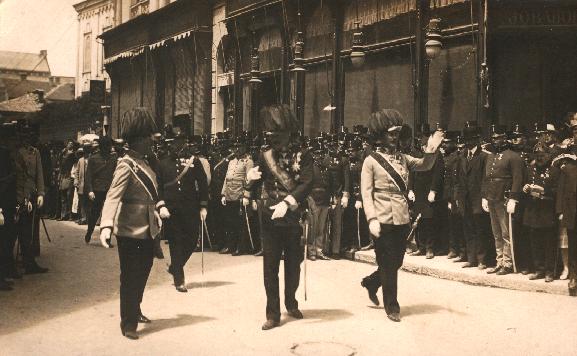
As explained,
the first "adoptee" was Archduke Franz Ferdinand, b 1863 (not descended from Mary Beatrice d'Este), who took the
name Austria Este, and also in 1896 became the heir presumptive of the Austrian Empire, but was murdered 28 June 1914 in Sarajevo.
Since his own children were born in morganatic marriage(Hohenberg), the Habsburgs designated his soon-to-be born great-nephew Robert, b 8 Feb 1915, second son of the future emperor Charles,
as the next "adopted Austria-Este". Through his mother Zita of Parma (a great-granddaughter of Teresa of Savoy,
Duchess of Lucca and Parma, who was daughter of Teresa of Modena, Queen of Sardinia, who was daughter of Mary Beatrice d'Este
and Ferdinand of Austria, Duchess and Duke of Breisgau and Modena), Archduke Robert happened to be a descendant of Duke Ercole
III d'Este and thus the blood of last Este dukes joined with the name Austria-Este. Archduke Robert decreed that all his descendants
in male line are entitled to the surname Austria-Este, and he took also the title Duke of Este, which is intended to be carried
by the head of the family of Austria-Este. 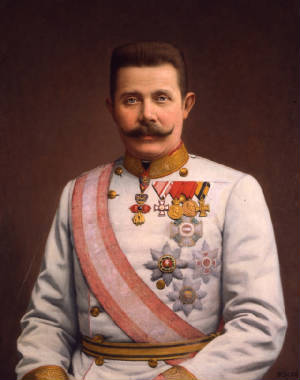
Today,
the carrier of such tradition is Archduke Lorenz Otto Charles of Austria-Este, born 1955, eldest son of Archduke Robert and
Princess Margherita of Savoy-Aosta. Archduke Lorenz is married to Princess Astrid of Belgium, the only daughter of King Albert
II of Belgium. Since the throne of Belgium is inheritable also by females (and males no longer have precedence over females),
Princess Astrid is the heiress of Belgium immediately after the issue of Crown Prince Philip. As such, her husband Archduke
Lorenz of Austria-Este, Duke of Este, was in 1995 elevated to the additional title of Prince of Belgium. The children of the
couple are since 1991 titled Archduke (Archduchess) of Austria-Este and Prince(ss) of Belgium. The eldest of these is Prince
Amedeo of Belgium, Archduke of Austria-Este, born 1986.
The House of Habsburg-Lorraine The House of Habsburg or Hapsburg (also known as House of
Austria) was one the most important royal houses of Europe and is best known for being an origin of all of the formally elected
Holy Roman Emperors between 1438 and 1740, as well as rulers of the Austrian and Spanish Empires and several other countries.
Originally from Switzerland, the dynasty first reigned in Austria, which they ruled for over six centuries. A series of dynastic
marriages brought Burgundy, Spain, Bohemia, Hungary, and other territories into the inheritance. In the 16th century the family
separated into the senior Habsburg Spain and the junior Habsburg Austrian branches. 
As
royal houses are by convention determined via the male line, the reigning branches of the House of Habsburg became extinct
in the 18th century. The Spanish branch ended upon the death of Charles II in 1700 and was replaced by the Anjou branch of
the House of Bourbon in the person of his great-nephew Philip V. The Austrian branch became extinct in 1780 with the death
of the Empress Maria Theresa and was replaced by the Vaudemont branch of the House of Lorraine in the person of her son Joseph
II. The new successor house styled itself as the House of Habsburg-Lorraine (German: Habsburg-Lothringen), therefore technically
there is not a House of Habsburg in the present day but only a female Habsburg line that exists in the House of Lorraine known as the House
of Habsburg-Lorraine. 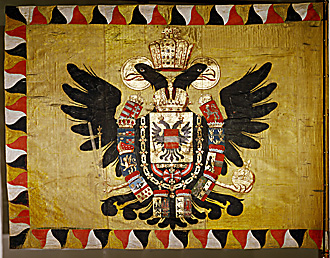
Titles
and Styles of The Imperial and Royal House The members of this family bear the titles "Archduke (Archduchess) of Austria, Prince
(Princess) of Hungary and Bohemia", and the style of "Imperial and Royal Highness". Descendants of morganatic
marriages, other than those granted specific titles (e.g., the Grafen von Meran and the Princes von Altenburg and Hohenberg)
generally bear the title "Graf (Gräfin) von Habsburg-Lothringen", or at least the surname "Habsburg". Genealogy of the Imperial and Royal House Part: I Maria Theresia, Archduchess of Austria, daughter of
Emperor Karl VI, was b.Vienna 13 May 1717; she succeeded her father as Queen of Hungary and Bohemia and heiress of Austria
on his death in 1740; she d.at Vienna 29 Nov 1780; she had married at Vienna 12 Feb 1736 Francis Stephen, Duke of Lorraine
(Lothringen) (Lunéville 8 Dec 1708-Innsbruck 18 Aug 1765), who in 1745 became the Emperor FRANZ I. Their issue:
1a) Marie Elisabeth Amalie Antonie Josephe Gabriele Johanna Agathe (Vienna 5 Feb 1737-Laxenburg
7 Jun 1740) 2a)
Marie Anna Josephe Antonie Johanna (Vienna 6 Oct 1738-Vienna 19 Nov 1789)
3a) Marie Caroline Ernestine Antonie Johanna
Josephe (Vienna 12 Jan 1740-Vienna 25 Jan 1741) 4a)
Emperor JOSEF II Benedikt August Johann Anton Michael Adam (Schönbrunn 13 Mar 1741-Vienna 20 Feb 1790); m.1st by proxy
at Parma 7 Sep 1760 and in person at Vienna 6 Oct 1760 Isabella Maria Pss of Bourbon-Parma (Madrid 31 Dec 1741-Vienna 27 Nov
1763); m.2d by proxy at Munich 13 Jan 1765 and in person at Schönbrunn 23 Jan 1765 Marie Josephe Pss of Bavaria (Munich
30 Mar 1739-Vienna 28 May 1767) 1b) Maria Theresia (Vienna 20 Mar 1762-Vienna 23 Jan 1770) 2b) Christina (b.and d.Vienna 22 Nov 1763) 5a) Marie Christine Johanna Josephe Antonie (Vienna 13 May 1742-Vienna 24 Jun
1798); m.Vienna 8 Apr 1766 Albert Pr of Saxony, Duke of Teschen (Moritzburg 11 Jul 1738-Vienna 10 Feb 1822)
6a)
Marie Elisabeth Josephe Johanna Antonie (Vienna 13 Aug 1743-Linz 22 Sep 1808) 7a)
Karl Joseph Emanuel Johann Nepomuck Anton Prokop (Vienna 1 Feb 1745-Vienna 18 Jan 1761) 8a)
Marie Amalie Josepha Johanna Antonie (Vienna 26 Feb 1746-Prague 18 Jun 1804); m.by proxy at Vienna 27 Jun 1769 and in person
at Colorno 19 Jul 1769 Ferdinando, Duke of Parma (Parma 20 Jan 1851-Fontevivo 9 Oct 1802) 9a)
Emperor Peter LEOPOLD II Joseph (Schönbrunn 5 May 1747-Vienna 1 Mar 1792), succeeded his brother, Emperor Joseph II,
on 20 Feb 1790; he m.by proxy at Madrid 16 Feb 1764 and in person at Innsbruck 5 Aug 1765 Maria Luisa Infanta of Spain (Naples
24 Nov 1745-Vienna 15 May 1792) 1b)
Maria Theresia Josephe Charlotte Johanna (Florence 14
Jan 1767-Leipzig 7 Nov 1827); m.by proxy at Florence 8 Sep 1787 and in person at Dresden 18 Oct 1787 King Anton of Saxony
(Dresden 27 Dec 1755-Pillnitz 6 Jun 1836) 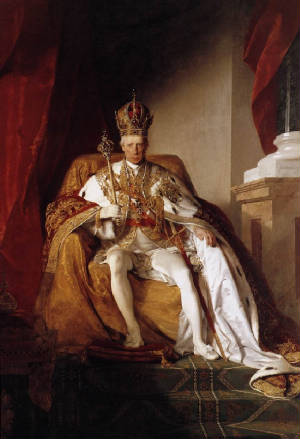 2b) Emperor
FRANZ II Joseph Karl, who in 1806 abdicated as Holy Roman Emperor and became Emperor FRANZ of Austria, (Florence 12 Feb 1768-Vienna
2 Mar 1835); m.1st Vienna 6 Jan 1788 Elisabeth Dss of Württemberg (Treptow 21 Apr 1767-Vienna 18 Feb 1790); m.2d by proxy
at Naples 15 Aug 1790 and in person at Vienna 19 Sep 1790 Maria Teresa Pss of Bourbon-Two Sicilies (Naples 6 Jun 1772-Vienna
13 Apr 1807); m.3d Vienna 6 Jan 1808 Maria Ludowika Archdss of Austia-Este (Monza 14 Dec 1787-Verona 7 Apr 1816); m.4th by
proxy at Munich 29 Oct 1816 and in person at Vienna 10 Nov 1816 Caroline Auguste Pss of Bavaria (Mannheim 8 Feb 1792-Vienna
9 Feb 1873) 1c) Ludovika Elisabeth Franziska (Vienna 18 Feb 1790-Vienna 24 Jun
1791) 2c) Marie
Louise Leopoldine Franziska Theresia Josepha Lucia, Dss of Parma, Piacenza and Guastalla 1814-1847 (Vienna 12 Dec 1791-Vienna
17 Dec 1847); m.1st by proxy at Vienna 11 Mar 1810 and in person (civ) at St.Cloud 1 Apr 1810 (rel) at the Louvre 2 Apr 1810
Napoléon I, Emperor of the French (Ajaccio 15 Aug 1769-St.Helena 5 May 1821); m.2d Parma 7 Sep 1821 Adam Adalbert Gf
von Neipperg (Vienna 8 Apr 1775-Parma 22 Feb 1829); m.3d Parma 17 Feb 1834 Cte Charles de Bombelles (Versailles 6 Nov 1785-
Versailles 30 May 1856) 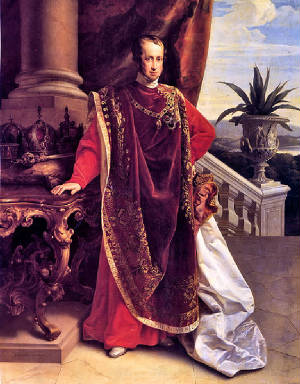 3c) FERDINAND I
Karl Leopold Joseph Franz Marcelin, Emperor of Austria from the death of his father until his abdication 2 Dec 1848 (Vienna
19 Apr 1793-Prague 29 Jun 1875); m.Vienna 27 Feb 1831 Maria Anna Pss of Savoy (Rome 19 Sep 1803-Prague 4 May 1884)
4c) Marie Caroline Leopoldine
Franziska Theresia Josepha Medarde (Vienna 8 Jun 1794-Vienna 16 Mar 1795)
5c) Caroline Ludovika Leopoldine (Vienna
9 Dec 1795-Schloß Hetzendorf 30 Jun 1799) 6c) Maria Leopoldina Josepha Caroline (Vienna 22 Jan 1797-Rio de Janeiro 11 Dec 1826); m.by proxy at Vienna 13 May
1817 and in person at Rio de Janeiro 5 Nov 1817 Pedro I, Emperor of Brazil [later, King Pedro IV of Portugal (Queluz 12 Oct
1798-Queluz 24 Sep 1834) 7c) Marie Clementine Franziska Josepha (Vienna 1 Mar 1798-Château de Chantilly 3 Sep 1881); m.Schönbrunn
28 Jul 1816 Leopoldo Pr of Bourbon-Two Sicilies, Pr di Salerno (Naples 2 Jul 1790-Naples 10 Mar 1851)
8c)
Joseph Franz Leopold (Vienna 9 Apr 1799-Laxenburg 30 Jun 1807) 9c) Marie Caroline Ferdinande Theresia Josephine Demetria (Vienna 8 Apr 1801-Dresden 22 May 1832); m.by proxy at
Vienna 26 Sep 1819 and in person at Dresden 7 Oct 1819 King Friedrich August II of Saxony (Dresden 18 May 1797-Brennbuchel
9 Aug 1854. 10c) Franz Karl Joseph (Vienna 7 Dec 1802-Vienna 8 Mar 1878); he renounced his succession rights 1848;
m.Vienna 4 Nov 1824 Sophie Pss of Bavaria (Munich 27 Jan 1805-Vienna 28 May 1872)  1d) FRANZ JOSEPH Karl,
Emperor of Austria 2 Dec 1848 (Schönbrunn 18 Aug 1830-Schönbrunn 21 Nov 1916); m.Vienna 24 Apr 1854 Elisabeth Dss
in Bavaria (Munich 24 Dec 1837-assassinated at Geneva 10 Sep 1898) . 1e) Sophie Friederike Dorothea Maria Josepha (Vienna 5 Mar 1855-Buda 29 May 1857) 2e) Gisela
Louise Marie (Laxenburg 12 Jul 1856-Munich 27 Jul 1932); m.Vienna 20 Apr 1875 Leopold Pr of Bavaria (Munich 9 Feb 1846-Munich
28 Sep 1930) 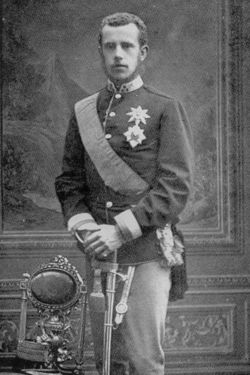
3e) Rudolf Franz Karl Joseph, Crown
Prince of Austria (Laxenburg 21 Aug 1858-committed suicide at Mayerling 30 Jan 1889); m.Vienna 10 May 1881 Stephanie Pss of
Belgium (Laeken 21 May 1864-Pannonhalma, Hungary 23 Aug 1945) 1f) Elisabeth Marie Henriette
Stephanie Gisela (Laxenburg 2 Sep 1883- Vienna-Hütteldorf 22 Mar 1963); m.1st Vienna 23 Jan 1902 (div 1924) Otto Pr zu
Windisch-Grätz (Graz 7 Oct 1873-Lugano 25 Dec 1952); m.2d Vienna 4 May 1948 Leopold Petznek (Bruck an der Leitha 30 Jun
1881-Vienna 27 Jul 1956) 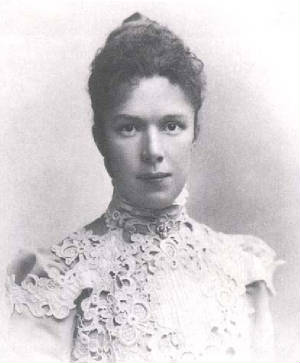 4e) Marie Valerie Mathilde Amalie (Buda 22 Apr 1868-Schloß
Wallsee 6 Sep 1924); m.Ischl 31 Jul 1890 Franz Salvator Archduke of Austria (Altmünster 21 Aug 1866-Vienna 20 Apr 1939) 2d) Ferdinand Maximilian, b.Vienna 6 Jul
1832, became Emperor Maximilian of Mexico 10 Apr 1864 but was ousted by revolutionaries and executed at Queretaro, Mexico
19 Jun 1867; m.Brussels 27 Jul 1857 Charlotte Pss of Belgium (Laeken 7 Jun 1840-Château de Bouchout, Belgium 19 Jan
1927) 3d) Karl Ludwig (Schönbrunn 30 Jul 1833-Vienna 19 May 1896); m.1st Dresden 4 Nov 1856
Margaretha Pss of Saxony (Dresden 24 May 1840-Monza 15 Sep 1858); m.2d by proxy at Rome 16 Oct 1862 and in person at Venice
21 Oct 1862 Maria Annunciata Pss of Bourbon-Two Sicilies (Caserta 24 Mar 1843-Vienna 4 May 1871); m.3d Kleinheubach 23 Jul
1873 Maria Teresa Infanta of Portugal (Kleinheubach 24 Aug 1855-Vienna 12 Feb 1944) . 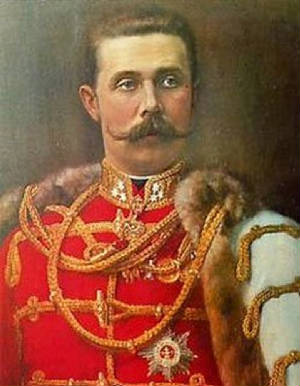 1e) Franz Ferdinand Karl Ludwig Joseph, who became heir presumptive to the Imperial Throne on the death of his cousin,
the Crown Prince Rudolf, in 1889 (Graz 18 Dec 1863-assassinated at Sarajevo 28 Jun 1914); m.(morganatically) at Reichstadt,
Bohemia 1 Jul 1900 Sophie Gfn Chotek von Chotkowa, who was in 1905 cr Herzogin von Hohenberg (Durchlaucht) (Stuttgart 1 Mar
1868-assassinated at Sarajevo 28 Jun 1914); their issue bear the titles Fürst[in] von Hohenberg (Durchlaucht), except
the head of the house, who is Herzog von Hohenberg 1f) Sophie Marie Franziska Antonia Ignatia Alberta (Konopischt 24
Jul 1901-Thannhausen 27 Oct 1990); m.Tetschen 8 Sep 1920 Friedrich Gf von Nostitz-Rieneck (Prague 1 Nov 1893-Graz 29 Dec 1973)
see: Dukes of Hohenberg - House of Hohenberg 2e) Otto Franz Joseph Karl Ludwig Maria (Graz 21 Apr 1865-Vienna 1 Nov 1906); m.Dresden 2 Oct 1886 Maria Josepha
Pss of Saxony (Dresden 31 May 1867-Schloß Wildenwart, Upper Bavaria 28 May 1944) 1f) KARL, Emperor of Austria on the death of his great-uncle, Emperor Franz Josef, in 1916, until he fled
the country in 1918/9; b.Persenbeug 17 Aug 1887, d.Funchal, Madeira 1 Apr 1922; m.Schwarzau am Steinfelde 21 Oct 1911 Zita
Pss of Bourbon-Parma (Villa Pianore 9 May 1892-Zizers 14 Mar 1989)  1g) Franz Joseph OTTO Robert
Maria Anton Karl Max Heinrich Sixtus Xaver Felix Renatus Ludwig Gaetan Pius Ignatius, relinquished status as head of house
to his son Karl 2007 (Villa Wartholz bei Reichenau, Lower Austria 20 Nov 1912-Pöcking 4 Jul 2011); m.Nancy 10 May 1951
Regina Pss of Saxe-Meiningen (Würzburg 6 Jan 1925-Pöcking 3 Feb 2010) 1h) Andrea Maria, b.Würzburg 30 May 1953; m.(civ) Pöcking, Upper Bavaria 9 Jul
1977 (rel) 30 Jul 1977 Karl Eugen Erbgf von Neipperg (b.Schwaigern 20 Oct 1951) 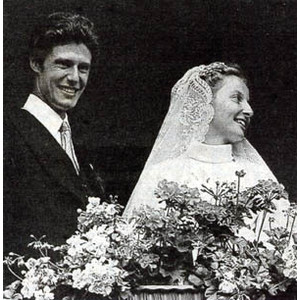 2h)
Monika Maria Roberta Antonia Raphaela, b.Würzburg 13 Sep 1954; m.Pöcking 21 Jun 1980 Don Luis Gonzaga de Casanova-Cárdenas
y Barón Duque de Santangelo Marqués de Elche Cde de Lodosa (b.Madrid 24 Apr 1950) 3h) Michaela Maria Madeleine Kiliana Elisabeth, b.Würzburg 13 Sep 1954; m.1st (civ) 12 Jul 1982 (rel)
Anton, Panama 14 Jan 1984 (div 1993) Eric Alba Teran d'Antin (Mexico City 21 May 1920-New York 9 Jul 2004 [acc to internet
reports, not confirmed); m.2d 22 Oct 1994 (div 1998) Hubertus Gf von Kageneck (b.Haus Blumenscheidt bei Wittlich 10 Aug 1940) 4h) Gabriela Maria Charlotte Felicitas Elisabeth Antonia, b.Luxemburg 14 Oct 1956; m.(civ)
Pöcking 30 Aug 1978 (rel) St.Odile 5 Sep 1978 (div 1997) Christian Meister (b.Starnberg 1 Sep 1954) 5h) Walburga Maria Franziska Helene Elisabeth, b.Berg am Starnberger See 5 Oct 1958; m.Budapest
5 Dec 1992 Carl Axel Archibald Gf Douglas (b.Stockholm 27 Nov 1949) 6h) KARL Thomas Robert Maria
Franziskus Georg Bahnam, b.Starnberg 11 Jan 1961; m.Mariazell 31 Jan 1993 (civ) Salzburg 6 Feb 1993 Bss Francesca von Thyssen-Bornemisza
(b.Lausanne 7 Jun 1958) 1i) Eleonore Jelena Maria del Pilar Iona, b.Salzburg
28 Feb 1994
2i) Ferdinand Zvonimir Maria Balthus Keith Michal Otto
Antal Bahnam Leonhard, b.Salzburg 21 Jun 1997
3i) Gloria Maria
Bogdana Paloma Regina Fiona Gabriela, b.Salzburg 15 Oct 1999
|

